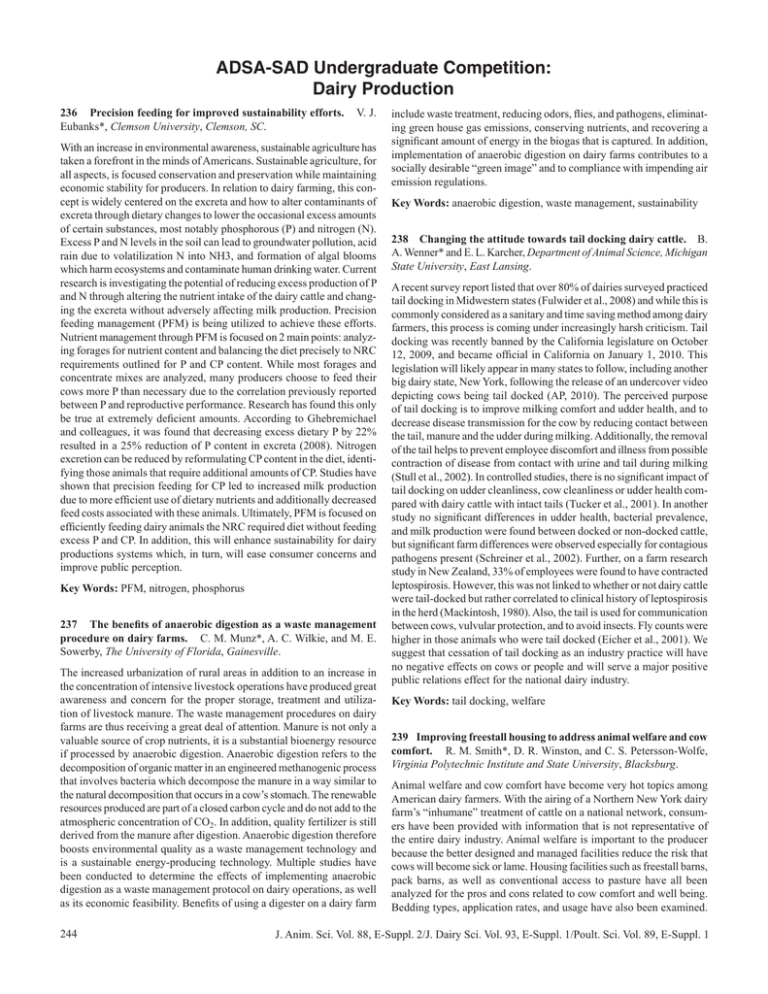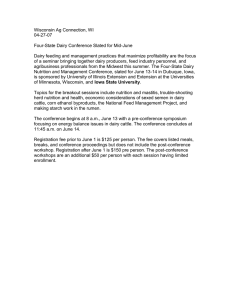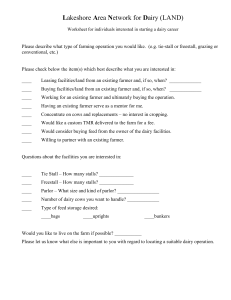include waste treatment, reducing odors, flies, and pathogens, eliminat- Clemson University
advertisement

ADSA-SAD Undergraduate Competition: Dairy Production 236 Precision feeding for improved sustainability efforts. V. J. Eubanks*, Clemson University, Clemson, SC. With an increase in environmental awareness, sustainable agriculture has taken a forefront in the minds of Americans. Sustainable agriculture, for all aspects, is focused conservation and preservation while maintaining economic stability for producers. In relation to dairy farming, this concept is widely centered on the excreta and how to alter contaminants of excreta through dietary changes to lower the occasional excess amounts of certain substances, most notably phosphorous (P) and nitrogen (N). Excess P and N levels in the soil can lead to groundwater pollution, acid rain due to volatilization N into NH3, and formation of algal blooms which harm ecosystems and contaminate human drinking water. Current research is investigating the potential of reducing excess production of P and N through altering the nutrient intake of the dairy cattle and changing the excreta without adversely affecting milk production. Precision feeding management (PFM) is being utilized to achieve these efforts. Nutrient management through PFM is focused on 2 main points: analyzing forages for nutrient content and balancing the diet precisely to NRC requirements outlined for P and CP content. While most forages and concentrate mixes are analyzed, many producers choose to feed their cows more P than necessary due to the correlation previously reported between P and reproductive performance. Research has found this only be true at extremely deficient amounts. According to Ghebremichael and colleagues, it was found that decreasing excess dietary P by 22% resulted in a 25% reduction of P content in excreta (2008). Nitrogen excretion can be reduced by reformulating CP content in the diet, identifying those animals that require additional amounts of CP. Studies have shown that precision feeding for CP led to increased milk production due to more efficient use of dietary nutrients and additionally decreased feed costs associated with these animals. Ultimately, PFM is focused on efficiently feeding dairy animals the NRC required diet without feeding excess P and CP. In addition, this will enhance sustainability for dairy productions systems which, in turn, will ease consumer concerns and improve public perception. Key Words: PFM, nitrogen, phosphorus 237 The benefits of anaerobic digestion as a waste management procedure on dairy farms. C. M. Munz*, A. C. Wilkie, and M. E. Sowerby, The University of Florida, Gainesville. The increased urbanization of rural areas in addition to an increase in the concentration of intensive livestock operations have produced great awareness and concern for the proper storage, treatment and utilization of livestock manure. The waste management procedures on dairy farms are thus receiving a great deal of attention. Manure is not only a valuable source of crop nutrients, it is a substantial bioenergy resource if processed by anaerobic digestion. Anaerobic digestion refers to the decomposition of organic matter in an engineered methanogenic process that involves bacteria which decompose the manure in a way similar to the natural decomposition that occurs in a cow’s stomach. The renewable resources produced are part of a closed carbon cycle and do not add to the atmospheric concentration of CO2. In addition, quality fertilizer is still derived from the manure after digestion. Anaerobic digestion therefore boosts environmental quality as a waste management technology and is a sustainable energy-producing technology. Multiple studies have been conducted to determine the effects of implementing anaerobic digestion as a waste management protocol on dairy operations, as well as its economic feasibility. Benefits of using a digester on a dairy farm 244 include waste treatment, reducing odors, flies, and pathogens, eliminating green house gas emissions, conserving nutrients, and recovering a significant amount of energy in the biogas that is captured. In addition, implementation of anaerobic digestion on dairy farms contributes to a socially desirable “green image” and to compliance with impending air emission regulations. Key Words: anaerobic digestion, waste management, sustainability 238 Changing the attitude towards tail docking dairy cattle. B. A. Wenner* and E. L. Karcher, Department of Animal Science, Michigan State University, East Lansing. A recent survey report listed that over 80% of dairies surveyed practiced tail docking in Midwestern states (Fulwider et al., 2008) and while this is commonly considered as a sanitary and time saving method among dairy farmers, this process is coming under increasingly harsh criticism. Tail docking was recently banned by the California legislature on October 12, 2009, and became official in California on January 1, 2010. This legislation will likely appear in many states to follow, including another big dairy state, New York, following the release of an undercover video depicting cows being tail docked (AP, 2010). The perceived purpose of tail docking is to improve milking comfort and udder health, and to decrease disease transmission for the cow by reducing contact between the tail, manure and the udder during milking. Additionally, the removal of the tail helps to prevent employee discomfort and illness from possible contraction of disease from contact with urine and tail during milking (Stull et al., 2002). In controlled studies, there is no significant impact of tail docking on udder cleanliness, cow cleanliness or udder health compared with dairy cattle with intact tails (Tucker et al., 2001). In another study no significant differences in udder health, bacterial prevalence, and milk production were found between docked or non-docked cattle, but significant farm differences were observed especially for contagious pathogens present (Schreiner et al., 2002). Further, on a farm research study in New Zealand, 33% of employees were found to have contracted leptospirosis. However, this was not linked to whether or not dairy cattle were tail-docked but rather correlated to clinical history of leptospirosis in the herd (Mackintosh, 1980). Also, the tail is used for communication between cows, vulvular protection, and to avoid insects. Fly counts were higher in those animals who were tail docked (Eicher et al., 2001). We suggest that cessation of tail docking as an industry practice will have no negative effects on cows or people and will serve a major positive public relations effect for the national dairy industry. Key Words: tail docking, welfare 239 Improving freestall housing to address animal welfare and cow comfort. R. M. Smith*, D. R. Winston, and C. S. Petersson-Wolfe, Virginia Polytechnic Institute and State University, Blacksburg. Animal welfare and cow comfort have become very hot topics among American dairy farmers. With the airing of a Northern New York dairy farm’s “inhumane” treatment of cattle on a national network, consumers have been provided with information that is not representative of the entire dairy industry. Animal welfare is important to the producer because the better designed and managed facilities reduce the risk that cows will become sick or lame. Housing facilities such as freestall barns, pack barns, as well as conventional access to pasture have all been analyzed for the pros and cons related to cow comfort and well being. Bedding types, application rates, and usage have also been examined. J. Anim. Sci. Vol. 88, E-Suppl. 2/J. Dairy Sci. Vol. 93, E-Suppl. 1/Poult. Sci. Vol. 89, E-Suppl. 1 Research has been conducted on freestall design to examine the type and size is most desirable for cow comfort. Improving freestall design will improve cow comfort and in return may improve public perception of the dairy industry. Animals rested an average of 0.7 h less in stalls measuring 106 cm than in stalls measuring 116 or 126 cm (Tucker et al., 2004). A second experiment showed that the difference in lying time was 1.2 h in stalls measuring 112 cm versus 132 cm (Tucker et al., 2004). Overall, animals preferred wider stalls. The amount of fecal matter increased 2.4 times in stalls measuring 126 cm, and 1.6 times more for 116 cm in width, compared with 106 cm stalls (Tucker et al., 2004). Stocking density, bunk space, surface type, and barrier type all have different effects on the performance and comfort of the animal. Time spent lying can comprise 40 to 60% of a cow’s life, and the surface is important for both the health and comfort of the animal (Tucker et al., 2003). Although cattle prefer deep bedding, deep bedding is more difficult for the producer to maintain and may cause more mastitis. Research generated by universities, professional organizations, research institutes, as well as personal experience should be considered when deciding on improvements or new facilities. Educated decisions on facility design will greatly improve cow comfort as well as the overall well-being of the animal. Key Words: animal welfare, cow comfort, freestall 240 Off to a good start. J. C. Landry* and C. C. Williams, Louisiana State University, Baton Rouge. Calves are the future lactating cows on the farm, so ensuring their health and well-being is vital to the dairy operation. A neonatal calf is born with an immature immune system, meaning that these animals are not able to produce antibodies when challenged with a disease causing pathogen. This type of immunity, called active immunity, is acquired and begins to develop after the first 2 mo of life. Therefore, the neonatal dairy calf relies on passive immunity to fight diseases during this early part of life. The passive transfer of immunity is obtained by gut absorption of the antibodies present in colostrum. Without this passive transfer of antibodies, or immunoglobulins, into the blood, the calf will be at greater risk for many diseases. Colostrum, the first and most important feed given to a newborn calf, is the primary source of nutrients for the calf and also provides essential and irreplaceable antibodies. The 3 essential factors to consider in colostrum feeding and management are quality, quantity, and time. The calf′s ability to absorb the antibodies declines within hours after birth, and by 24 h the intestine is closed to absorption. Failure of passive transfer may occur if the calf is not given enough high quality colostrum within the first 24 h of life. According to the latest National Animal Health Monitoring System (NAHMS) data, failure of passive transfer of immunity on US dairy farms has dropped dramatically since 1991–1992′s level of more than 40%. But passive transfer failure still occurs on US dairy farms at the rate of 19.2%. A successful heifer-rearing program begins with the proper management of the newborn calf. The quality, quantity, and timing of colostrum are critical for passive transfer of immunity to the neonatal calf. Using recommended management practices for feeding colostrum to the newborn calf will get these young animals off to a good start in life. Key Words: calves, immunity, passive transfer 241 Hemorrhagic bowel syndrome: The mysterious killer. B. P. Cashell*, Pennsylvania State University, University Park. Hemorrhagic bowel syndrome (HBS) is an acute sporadic enteric disease that affects the small intestine of mature dairy cattle. It has been estimated that HBS is responsible for 2% of cattle deaths in North America. The disease is characterized by dark bloody stools, bloody diarrhea, shock, depression, and acute death. The cow’s extremities become cool, mucous membranes become pale, and rectal temperature is lower than normal. The disease occurs most frequently in the first 100 d of lactation. Sudden death is common, with large blood clots found in the intestinal area. It is estimated that 85% of HBS cases are fatal, and treatment methods are rarely successful. While the cause of HBS has not been specifically identified, there are many possible contributors to its onset. Several pathogens have been linked to HBS. Clostridium perfringens has been most strongly associated with the condition. According to Colorado State University, 82% of HBS cases had moderate to heavy growth of C. perfringens from fecal material. An Oregon State study implicated Aspergillus fumigates, a contaminant in fermented feeds, as another associated pathogen. Since treatment of HBS has been largely unsuccessful and its exact cause is unclear, current approaches to control HBS have included identifying and correcting management and environmental factors that may impair immunity. Other possible methods of prevention include vaccines and feed additives. Careful cost analysis associated with these measures is necessary before implementing expensive methods of HBS prevention that have undetermined effectiveness. The mystery of HBS will be unraveled through further research into the causes and risk factors associated with this condition. Key Words: hemorrhagic bowel syndrome, Clostridium perfringens 242 Compost bedded pack barns: Opportunities, challenges, and management considerations. C. M. Sheaffer* and J. M. Bewley, University of Kentucky, Lexington. A compost bedded pack barn, which relies on a large, open resting area, usually bedded with sawdust or dry, fine wood shavings, is a relatively new alternative for management of dairy cattle and their waste in a confinement setting. The soft, dirt-like texture of the compost absorbs shock, provides safe footing, and provides a comfortable resting surface for cows to lie down. Heat detection is improved as compared with concrete, because of less concern of slipping. The heating of the compost may kill some harmful bacteria, including mastitis-causing pathogens, which can help reduce the occurrence of environmental mastitis. When the compost is working properly and dry, it can also be conducive to cleaner cows. Properly composted material emits little odor and can be dried and spread onto fields. This may ultimately lead to better nutrient utilization and the dried compost is more easily handled than liquid manure. Adequate ventilation, achieved through high, open sidewalls, open-ridges, and appropriately placed fans, is essential. Daily turning and aeration of the compost is necessary to provide oxygen (12 to 16%) to the microbial population. Most producers use a cultivator, tines, or a rotary tiller attached to the rear of a skid steer or small tractor to stir the pack. The temperature of the pack should be monitored daily and must be maintained between 54 and 66°C to ensure an optimal environment for the bacterial population. For proper function, the amount of moisture added by cows through urination and defecation should be limited to 46 to 64% total moisture in the pack. To achieve this, an appropriate stocking rate is one cow per 80 to 100 ft2. Bedding particle size is also an important factor and should be a balance between coarse wood chips and sawdust to maximize absorbency and available carbon. New bedding is added to the pack when existing bedding is moist enough to stick to the cows when they get up. Though applications for compost bedded pack barns may be limited because of limited sawdust supplies, they remain a viable alternative for small dairy herds or special needs groups within larger herds. Key Words: compost bedded pack, dairy housing, composting J. Anim. Sci. Vol. 88, E-Suppl. 2/J. Dairy Sci. Vol. 93, E-Suppl. 1/Poult. Sci. Vol. 89, E-Suppl. 1 245







